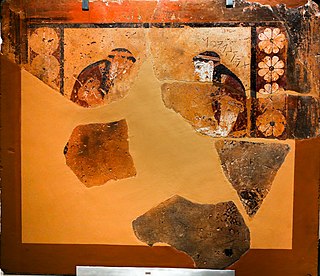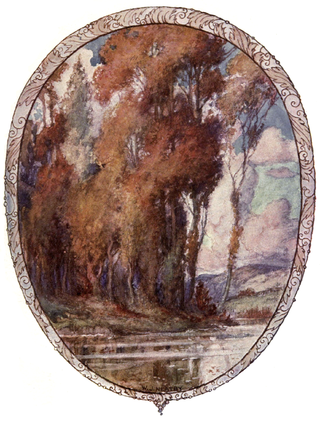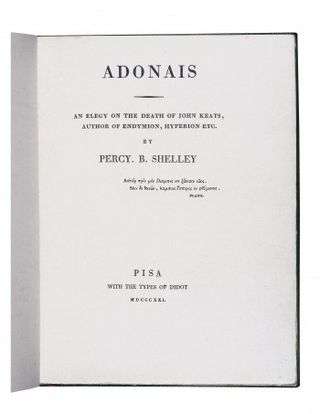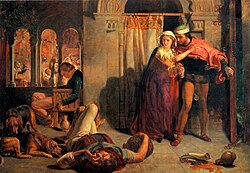
John Keats was an English poet of the second generation of Romantic poets, along with Lord Byron and Percy Bysshe Shelley. His poems had been in publication for less than four years when he died of tuberculosis at the age of 25. They were indifferently received in his lifetime, but his fame grew rapidly after his death. By the end of the century, he was placed in the canon of English literature, strongly influencing many writers of the Pre-Raphaelite Brotherhood; the Encyclopædia Britannica of 1888 called one ode "one of the final masterpieces".

Agnes of Rome is a virgin martyr, venerated as a saint in the Catholic Church, Oriental Orthodox Church and the Eastern Orthodox Church, as well as the Anglican Communion and Lutheran Churches. She is one of several virgin martyrs commemorated by name in the Canon of the Mass.

Philomela or Philomel is a minor figure in Greek mythology who is frequently invoked as a direct and figurative symbol in literary and artistic works in the Western canon.
Hyperion, a Fragment is an abandoned epic poem by 19th-century English Romantic poet John Keats. It was published in Lamia, Isabella, The Eve of St. Agnes, and Other Poems (1820). It is based on the Titanomachia, and tells of the despair of the Titans after their fall to the Olympians. Keats wrote the poem from late 1818 until the spring of 1819. The poem stops abruptly in the middle of the third book, with close to 900 lines having been completed. He gave it up as having "too many Miltonic inversions." He was also nursing his younger brother Tom, who died on 1 December 1818 of tuberculosis.

"To Autumn" is a poem by English Romantic poet John Keats. The work was composed on 19 September 1819 and published in 1820 in a volume of Keats's poetry that included Lamia and The Eve of St. Agnes. "To Autumn" is the final work in a group of poems known as Keats's "1819 odes". Although personal problems left him little time to devote to poetry in 1819, he composed "To Autumn" after a walk near Winchester one autumnal evening. The work marks the end of his poetic career, as he needed to earn money and could no longer devote himself to the lifestyle of a poet. A little over a year after the publication of "To Autumn", Keats died in Rome.

"Ode to a Nightingale" is a poem by John Keats written either in the garden of the Spaniards Inn, Hampstead, London or, according to Keats' friend Charles Armitage Brown, under a plum tree in the garden of Keats' house at Wentworth Place, also in Hampstead. According to Brown, a nightingale had built its nest near the house that he shared with Keats in the spring of 1819. Inspired by the bird's song, Keats composed the poem in one day. It soon became one of his 1819 odes and was first published in Annals of the Fine Arts the following July. The poem is one of the most frequently anthologized in the English language.

"Ode on a Grecian Urn" is a poem written by the English Romantic poet John Keats in May 1819, first published anonymously in Annals of the Fine Arts for 1819.

The "Ode on Indolence" is one of five odes composed by English poet John Keats in the spring of 1819. The others were "Ode on a Grecian Urn", "Ode on Melancholy", "Ode to a Nightingale" and "Ode to Psyche". The poem describes the state of indolence, a word which is synonymous with "avoidance" or "laziness". The work was written during a time when Keats was presumably more than usually occupied with his material prospects. After finishing the spring poems, Keats wrote in June 1819 that its composition brought him more pleasure than anything else he had written that year. Unlike the other odes he wrote that year, "Ode on Indolence" was not published until 1848, 27 years after his death.
"Lamia" is a narrative poem written by the English poet John Keats, which first appeared in the volume Lamia, Isabella, the Eve of St Agnes and Other Poems, published in July 1820. The poem was written in 1819, during the famously productive period that produced his 1819 odes. It was composed soon after his "La Belle Dame sans Merci" and his odes on Melancholy, on Indolence, on a Grecian Urn and to a Nightingale and just before "To Autumn".

Adonais: An Elegy on the Death of John Keats, Author of Endymion, Hyperion, etc. is a pastoral elegy written by Percy Bysshe Shelley for John Keats in 1821, and widely regarded as one of Shelley's best and best-known works. The poem, which is in 495 lines in 55 Spenserian stanzas, was composed in the spring of 1821 immediately after 11 April, when Shelley heard of Keats' death. It is a pastoral elegy, in the English tradition of John Milton's Lycidas. Shelley had studied and translated classical elegies. The title of the poem is modelled on ancient works, such as Achilleis, an epic poem by the 1st-century AD Roman poet Statius, and refers to the untimely death of the Greek Adonis, a god of fertility. Some critics suggest that Shelley used Virgil's tenth Eclogue, in praise of Cornelius Gallus, as a model.

Isabella, or the Pot of Basil (1818) is a narrative poem by John Keats adapted from a story in Boccaccio's Decameron. It tells the tale of a young woman whose family intend to marry her to "some high noble and his olive trees", but who falls for Lorenzo, one of her brothers' employees. When the brothers learn of this, they murder Lorenzo and bury his body. His ghost informs Isabella in a dream. She exhumes the body and buries the head in a pot of basil which she tends obsessively, while pining away.

Mariana is an 1851 oil-on-panel painting by John Everett Millais. The image depicts the solitary Mariana from William Shakespeare's Measure for Measure, as retold in Tennyson's 1830 poem "Mariana". The painting is regarded as an example of Millais's "precision, attention to detail, and stellar ability as a colorist". It has been held by Tate Britain since 1999.

In 1819, John Keats composed six odes, which are among his most famous and well-regarded poems. Keats wrote the first five poems, "Ode on a Grecian Urn", "Ode on Indolence", "Ode on Melancholy", "Ode to a Nightingale", and "Ode to Psyche" in quick succession during the spring, and he composed "To Autumn" in September. While the exact order in which Keats composed the poems is unknown, some critics contend that they form a thematic whole if arranged in sequence. As a whole, the odes represent Keats's attempt to create a new type of short lyrical poem, which influenced later generations.
This article lists the complete poetic bibliography of John Keats (1795–1821), which includes odes, sonnets and fragments not published within his lifetime, as well as two plays.

"Mariana" is a poem by Alfred, Lord Tennyson, published in 1830. The poem follows a common theme in much of Tennyson's work—that of despondent isolation. The subject of "Mariana" is a woman who continuously laments her lack of connection with society. The isolation defines her existence, and her longing for a connection leaves her wishing for death at the end of every stanza. The premise of "Mariana" originates in William Shakespeare's Measure for Measure, but the poem ends before Mariana's lover returns. Tennyson's version was adapted by others, including John Everett Millais and Elizabeth Gaskell, for use in their own works. The poem was well received by critics, and it is described by critics as an example of Tennyson's skill at poetry.

"Wireless" is a short story by Rudyard Kipling. It was first published in Scribner's Magazine in 1902, and was later collected in Traffics and Discoveries. The sister-poem accompanying it, Butterflies or Kaspar's Song in Varda, Kipling claimed to have been a translation of an old Swedish poem, although this claim is unsubstantiated.
"In the Neolithic Age" is a poem by the English writer Rudyard Kipling. It was published in the December 1892 issue of The Idler and in 1896 in his poetry collection The Seven Seas. The poem is the source of the quotation: "There are nine and sixty ways of constructing tribal lays, / And every single one of them is right."
"Poetry and the Gods" is a short story by H. P. Lovecraft and Anna Helen Crofts. The two authors wrote the story in or shortly before the summer of 1920. It was published the following September in United Amateur, which credits Lovecraft as Henry Paget-Lowe. In the story, a young woman dreams that she has an audience with Zeus, who explains to her that the gods have been asleep and dreaming, but they have chosen a poet who will herald their awakening.
The Eve of Saint (St.) Mark is an English language poem by John Keats. It was left unfinished in 1819. It is related to his earlier poem written in the same year, The Eve of Saint Agnes.

"St. Agnes" is a poem by Alfred Tennyson, first published in 1837, revised in 1842, and retitled "St. Agnes' Eve" in 1857.















